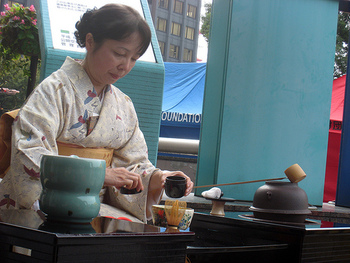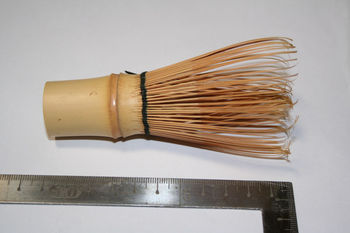Japanese Tea Ceremony
For the Japanese tea ceremony is not only preparation of a beverage. It also has much deeper, spiritual meaning. Japanese tea ceremony (chado or sado, "the way of tea") is influenced by Zen Buddhism.
It is actually the ceremonial preparation of powdered tea or matcha by specially trained person for a small group of guest. The most preferred number of guests is four. Everything is done in very peaceful atmosphere.
Tea ceremony can be performed as single event. This is called cha-no-you ("hot water of tea"). There is also cha-ji or chakai ("tea meeting") which is regarded as full tea ceremony. Such a ceremony includes kaiseki (“a light meal”), usucha (“thin tea”) and koicha (“thick tea”). This full ceremony can last for almost four hours.
 Japanese woman performing tea ceremony
Japanese woman performing tea ceremony
Person performing tea ceremony has to be very educated. Apart from all kind of knowledge about tea this person has to know many details about kimono, calligraphy, flower arranging, ceramics. That is why education of such person lasts for several years or even whole lifetime. The person performing tea ceremony usually wears kimono.
It has to be said that even being a guest at tea ceremony is not easy. Person has to learn all sorts of gestures, phrases etc.
What objects are needed to perform a Japanese tea ceremony? The equipment used in tea preparation is called dogu. Dogu includes numerous objects. Here are only the basic ones.
Chakin is a rectangular white linen or hemp cloth. It is used for ritual cleaning of the tea bowl.
Fukusa is a square silk cloth used for ritual cleaning of the tea scoop and the tea caddy. Fukusa also has a purpose to hold hot kettle or pot lids. Guests of the ceremony use fukusa to examine some objects during ceremony. Fukusa exists in different colours. Fukusa for men is usually purple and the one for women is orange or red.
Hishaku is a ladle. It is made of bamboo. Hisaku is used to move water to and from the iron pot and fresh water bowl.
Tana ("shelves") includes different elements of wooden or bamboo furniture used in tea ceremony
Chawan is a tea bowl. They slightly differ depending on the time of year when they are used. Shallow ones are used during summer because tea in them cools faster.
Chaki is a tea caddy. Chaki has two basic styles - natsume and cha-ire.
Chashaku is a tea scoop used to carry tea into the tea caddy. Chashaku is made from ivory, bamboo, Japanese apricot wood etc.
 chasen whisk
chasen whisk
Chasen is a whisk which is carved from bamboo. Old and damaged chasen are carried to temples where they are burned in the ceremony called chasen kuyo.
Japanese tea ceremony exists in several variations depending which traditional school is performing it. Three most famous schools are Omoteseneke, Urasenke and Sansenke.
Tea ceremonies are usually organized outside or in a tea room or a tea house.
Now something about the ceremony itself, the way it is actually performed. Guests entering the room where the ceremony is organized admire its beauty. Then everyone kneels on determined places on tatami mat.
When guests are seated, the host (ceremony performer) enters the room. He or she brings all the objects needed for tea ceremony. The host ritually cleans them with fukusa cloth. Moves during this process are specially determined. It takes lot of practice to learn them properly. Everything is done slowly, peacefully.
After this process the actual tea preparation starts. The water is boiled in metal or pottery kettle or pot. Hot water is then poured with the hishaku into the chawan.
The chasen (tea whisk) is checked in a ceremonial way before being used to whisk the hot water. The whisked water is then poured out into the kensui bowl and the tea bowl is cleaned with a chakin. This is done for two reasons. First, to clean the bowl after each guest has his tea, but also as part of the cleaning ritual.
The guest then gets some sweets. Sweets are eaten with a wooden pick called kuromoji. Sweets are served on a special napkin called kaishi.
When everything is clean, tea preparation begins. Little bit of powdered green tea (macha) is taken with the chashaku (tea scoop) out of the natsume (tea caddy), into the tea bowl. Hot water is then poured into the tea bowl.
The host whisks the tea and water quickly to prepare tea for the first guest. The first guest is offered tea by the host. He takes the tea. He apologizes to the guest sitting next to him for getting tea first. Then he thanks the host for the tea. The tea must be drank in three sips with some slurping on the last sip. The guest expresses his admiration about the bowl, its design etc.
The tea bowl is returned to host. He or she then repeats the whole process for other guests present at the ceremony. When all guests got their tea all objects used in the ceremony are cleaned again. Everything is returned on the tray. The hosts bows to the guests. They bow in return and thank him or her. The guests leave the room.